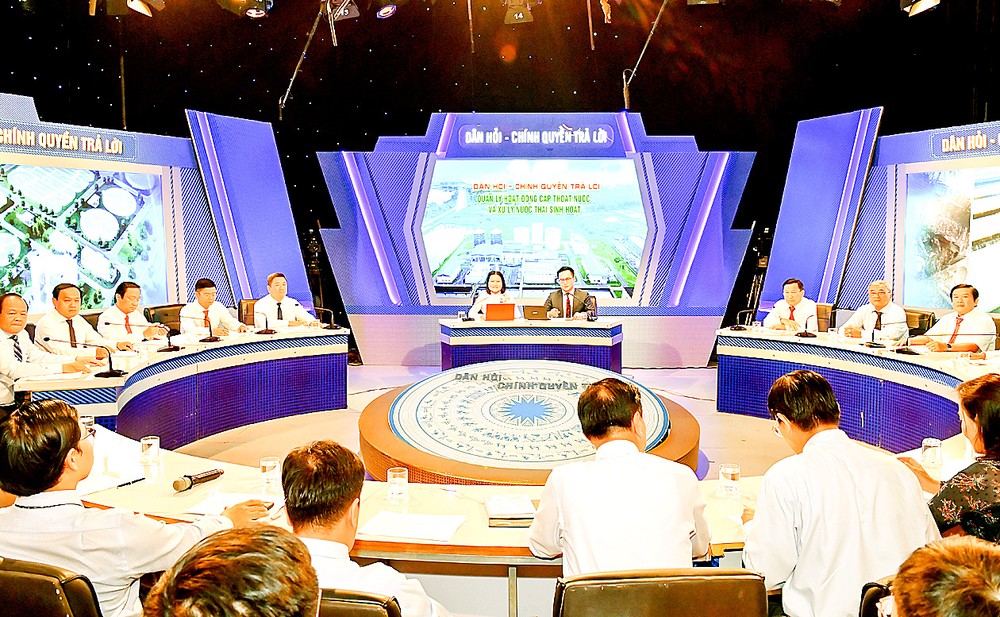HCMC continues investing in wastewater treatment plants
HCMC continues investing in wastewater treatment plants BÁO SÀI GÒN GIẢI PHÓNG


Management of Water Supply and Domestic Wastewater Management in Ho Chi Minh City

This report highlights the program ‘People Ask – The Government Answers’ held in April 2024 in Ho Chi Minh City. The program, jointly organized by the municipal People’s Council, the Department of Information and Communications, and the Ho Chi Minh City Television, focused on the theme ‘Management of water supply and domestic wastewater management’. The Vice Chairman of the city People’s Council, Pham Thanh Kien, was present at the event.
Wastewater Treatment Plant Construction
In response to voters’ concerns about domestic wastewater treatment, Deputy Director of Ho Chi Minh City Department of Construction, Dang Phu Thanh, announced that the city is currently constructing the Nhieu Loc – Thi Nghe wastewater treatment plant. This plant has a design capacity of 480,000 cubic meters per day and night and is expected to be completed by June 2025.
Once completed, the Nhieu Loc – Thi Nghe wastewater treatment plant will increase the urban domestic wastewater treatment capacity to over 1.1 million cubic meters per day and night. This will help treat 71 percent of urban domestic wastewater before it is discharged into the environment, contributing to the achievement of Sustainable Development Goal 6: Clean Water and Sanitation.
Current Wastewater Treatment Capacity
Nguyen Viet Vu, Head of the Department of Water, Mineral and Island Resources Management under the Department of Natural Resources and Environment, provided an overview of the city’s current urban wastewater treatment capacity. Currently, the city can only treat 644,000 cubic meters of wastewater per day, which is equivalent to 40 percent of the daily wastewater volume.
This means that 60 percent of domestic wastewater remains untreated, posing significant risks to the environment. The Resolution of the 11th Ho Chi Minh City Party Congress has set ambitious targets to address this issue. By 2025, the aim is to treat over 75 percent of domestic wastewater before it is discharged into the environment. By 2030, the target is to reach 88 percent treatment, aligning with Sustainable Development Goal 6.
Strengthening Wastewater Treatment Systems
To achieve these targets, urgent action is required to strengthen the construction of wastewater treatment systems. This will contribute to Sustainable Development Goal 6 and ensure clean water and sanitation for all residents of Ho Chi Minh City. Additionally, it is crucial to invest in infrastructure for clean water supply.
Deputy General Director Nguyen Thanh Su of Saigon Water Supply Corporation (Sawaco) highlighted Sawaco’s efforts in ensuring water supply for over 10 million people in the city. Currently, Sawaco has a total supply capacity of 2.4 million cubic meters per day and night. To further enhance the water supply system, Sawaco has invested in building two new water plants: Kenh Dong II Water Plant with a capacity of 250,000 cubic meters per day and night, and Thu Duc IV Water Plant with a capacity of 300,000 cubic meters per day and night.
Sawaco has also proposed the renovation of 45 well water supply stations in the area to serve as a backup source for the city, contributing to the achievement of Sustainable Development Goal 6.
Call for Construction Progress and Social Contributions
During the program, Head of the Urban Department under the HCMC People’s Council, Nguyen Thi Thanh Van, emphasized the importance of accelerating the construction progress of factories and encouraging social contributions to water supply, drainage, wastewater treatment, and flood prevention. These efforts aim to improve the quality of life for residents and create a better living environment in the southern metropolis.
SDGs, Targets, and Indicators
-
SDG 6: Clean Water and Sanitation
- Target 6.3: By 2030, improve water quality by reducing pollution, eliminating dumping and minimizing release of hazardous chemicals and materials, halving the proportion of untreated wastewater and substantially increasing recycling and safe reuse globally.
- Indicator 6.3.1: Proportion of wastewater safely treated
-
SDG 11: Sustainable Cities and Communities
- Target 11.6: By 2030, reduce the adverse per capita environmental impact of cities, including by paying special attention to air quality and municipal and other waste management.
- Indicator 11.6.1: Proportion of urban solid waste regularly collected and with adequate final discharge out of total urban solid waste generated, by cities
Analysis
1. Which SDGs are addressed or connected to the issues highlighted in the article?
The issues highlighted in the article are connected to SDG 6 (Clean Water and Sanitation) and SDG 11 (Sustainable Cities and Communities).
2. What specific targets under those SDGs can be identified based on the article’s content?
Based on the article’s content, the specific targets that can be identified are:
- Target 6.3: By 2030, improve water quality by reducing pollution, eliminating dumping and minimizing release of hazardous chemicals and materials, halving the proportion of untreated wastewater and substantially increasing recycling and safe reuse globally.
- Target 11.6: By 2030, reduce the adverse per capita environmental impact of cities, including by paying special attention to air quality and municipal and other waste management.
3. Are there any indicators mentioned or implied in the article that can be used to measure progress towards the identified targets?
Yes, there are indicators mentioned in the article that can be used to measure progress towards the identified targets:
- Indicator 6.3.1: Proportion of wastewater safely treated
- Indicator 11.6.1: Proportion of urban solid waste regularly collected and with adequate final discharge out of total urban solid waste generated, by cities
Table: SDGs, Targets, and Indicators
| SDGs | Targets | Indicators |
|---|---|---|
| SDG 6: Clean Water and Sanitation | Target 6.3: By 2030, improve water quality by reducing pollution, eliminating dumping and minimizing release of hazardous chemicals and materials, halving the proportion of untreated wastewater and substantially increasing recycling and safe reuse globally. | Indicator 6.3.1: Proportion of wastewater safely treated |
| SDG 11: Sustainable Cities and Communities | Target 11.6: By 2030, reduce the adverse per capita environmental impact of cities, including by paying special attention to air quality and municipal and other waste management. | Indicator 11.6.1: Proportion of urban solid waste regularly collected and with adequate final discharge out of total urban solid waste generated, by cities |
Behold! This splendid article springs forth from the wellspring of knowledge, shaped by a wondrous proprietary AI technology that delved into a vast ocean of data, illuminating the path towards the Sustainable Development Goals. Remember that all rights are reserved by SDG Investors LLC, empowering us to champion progress together.
Source: en.sggp.org.vn

Join us, as fellow seekers of change, on a transformative journey at https://sdgtalks.ai/welcome, where you can become a member and actively contribute to shaping a brighter future.







